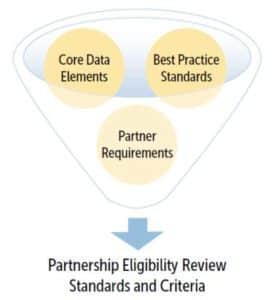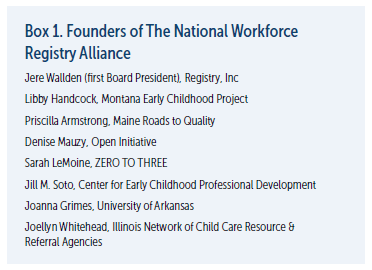Nikki Darling-Kuria, ZERO TO THREE, Washington, DC
Kelly Smith, Child Care Resource & Referral Association, Columbus, Ohio
Jill M. Soto, New World Now, Blanchard, Oklahoma
Joellyn Whitehead, Illinois Network of Child Care Resource & Referral Agencies, Bloomington, Illinois
Abstract
There are few sources of national data on the early childhood and school-age workforce. The National Workforce Registry Alliance is creating an important source of current, verified, longitudinal data on the early care and education field. The 2019 dataset analysis focused on the characteristics of infant–toddler educators to highlight the status of professional competence and identify areas for improving program quality. This article shares the history of the Registry Alliance and its vision for becoming a national contributor of data on the early childhood and school-age workforce.
The National Workforce Registry Alliance (Registry Alliance) is a private, nonprofit, voluntary organization of state and regional early childhood and afterschool workforce registry and professional development leaders. A registry is an information system for the early childhood and afterschool workforce that promotes professional growth and development; captures critical information about the workforce; recognizes professional achievements and milestones; provides data for compliance and quality initiatives; and informs administrators, innovators, and policymakers.
History of the Registry Alliance
In 2003, The Registry, Inc, Wisconsin’s recognition system for the early care and education field, which acknowledges and highlights the training, experience, and professionalism that are vital to quality early childhood and school age care, invited other states that were exploring or beginning to implement a registry to talk about the intricacies of registry work. The meeting was the beginning of what would become the Registry Alliance. In 2005 the organization became fully functioning, with written bylaws, when a group of stakeholders had a 2-day retreat in Bath, Maine. (see Box 1 for a list of the founding members.)
The Registry Alliance has worked to serve as the voice for state registries and advocated for why a registry is important. During 2011, the Registry Alliance, in partnership with ZERO TO THREE, served as a data and consulting partner for the Professional Development Workforce Center. In addition, the Registry Alliance participated in collaborations with the Center for the Study of Child Care Employment, Child Care Aware of America, and T.E.A.C.H. Early Childhood Project to create data alignment across various national stakeholders to inform better data collection and data sharing for early childhood workforce initiatives.
Essential Elements of a Registry
Registries were initially developed to collect and manage data for the purpose of providing recognition of professional achievements and to disseminate basic data for state and federal reporting needs. As registries have evolved, they have become an essential source for the data necessary to inform discussions and decisions around state and federal initiatives and policies.
In addition, registries have the ability to support the key elements of a state career development system. Key elements include:
- access and outreach
- quality assurance
- qualifications, credentials, and pathways
- core professional knowledge
- financing and compensation
States have myriad reasons for implementing an early childhood workforce registry and, regardless of the reason, running a workforce registry can seem daunting at times. The Registry Alliance provides a registry with a support system that includes standards regarding data collection as well as the ability to interact with other registry professionals all over the country. One area where support from other state registries can be very helpful is with the topic of membership. Some registries require membership, while others are completely voluntary. As participation in the national dataset by state registries increases, the Registry Alliance hopes to be able to demonstrate the critical need for each state to have a comprehensive early childhood workforce registry where the participation by all members of the workforce is seen as important and necessary to the success of the early childhood field.
Registry Goals and Benchmarks
The Registry Alliance celebrates the diversity of approaches used by individual registries. It seeks to promote the value of registries across the nation by supporting the collection of core data elements, which are standards for data collection as well as data policy and procedures that inform the implementation of standard operating practices for early childhood workforce registries. To ensure that workforce registries remain relevant and useful within state and national systems planning, in 2017 the Registry Alliance established national 5-year SOAR goals and benchmarks related to saturation (S), operations (O), accountability (A), and reciprocity ( R ).
Saturation
Saturation refers to supporting the increase in the number of workforce registries nationally and supporting an increase in registry participation by staff (i.e., teaching staff, directors) in licensed programs in states. In addition, not all states are currently providing data to the national dataset, so a Registry Alliance goal is to support all registries in providing some data points that can inform and support workforce data collection on a wider scale.
Currently, the Registry Alliance has:
- 6 associate members (registries in development) representing 5 states,
- 37 full registry members representing 36 states, and
- 44 total registry members representing 40 states. (There are two states with a full registry and an associate registry.)
By providing technical assistance to states, funders, and national initiatives on registry development, the Registry Alliance supports the growth of registry systems individually and collectively and gives the Registry Alliance a voice to inform.
Looking at Saturation includes participation rates within workforce registries. Participation is defined by registry funders, stakeholders, integration with the state’s licensing or Quality Rating Improvement System (QRIS), professional development, scholarships, or workforce initiatives. There are ongoing discussions at state and national levels on mandatory versus non-mandatory participation in a state/regional registry. Mandatory participation supports more robust workforce data collection and reporting. The data collected in a registry system can inform policymakers, stakeholders, and initiatives at the state and national levels.
Operations
Operations refers to ensuring that registries across the nation are meeting some minimum operating standards, thus solidifying the value of registry data on the nation’s early childhood workforce. The Registry Alliance wants to increase the effectiveness of registry operations for all types of data collection. The Registry Alliance provides best practice standards and core data elements to define data collection and looks to expand these best-practice standards by outlining a common set of standards of operations and core data elements for remaining registry functions.
The Registry Alliance recognizes that there are barriers to participation for all registry systems to inform national datasets. The Registry Alliance’s standard for participation is the Partnership Eligibility Review (PER), an approval process to determine a registry system’s readiness” for participation in data-related projects. The Registry Alliance acknowledges the biggest barrier, such as verified versus unverified data collection, and with this effort is looking for ways to collect the available verified data from all state systems. For example, if a state registry system cannot meet the rigorous PER standards, does that state verify education data or collect professional development data? If so, then can that data be collected outside of the PER-approved Registry Alliance National Dataset and do the data provide information that will be meaningful and useful to that state or region and to a smaller comprehensive dataset? The Registry Alliance believes that all states providing some level of data can inform the field. Some data is better than no data, providing the data is relevant, valid, and will support informing the workforce.
Accountability
Accountability measures will ensure registries are relevant as state and national early childhood workforce reporting systems. The Registry Alliance’s goal for accountability is to establish itself as the primary source of workforce data in the nation and establish the registry as the primary source of workforce data in respective service delivery areas. Are registries contributing to their state data metrics, and are they informing workforce data reports, supporting federal reporting for licensing and QRIS initiatives? To find out, the Registry Alliance will be surveying all registry systems for a 2020 State of the Registries report. The last survey was completed in 2012.
Reciprocity
Reciprocity refers to the ability for professional development to become portable across state lines and to the development of more streamlined processes for training organizations.
Many state registries are also Professional Development Registries. These systems provide trainer/training/sponsor approval based on the state and funder requirements. There is great interest in increasing the number of states using streamlined criteria for trainer/training/sponsor approval and in increasing the acceptance of credentials and training across registries. To this end, the Registry Alliance created Training Organization Recognition, a list of recognized training organizations. The list may be used by individual workforce registries to expedite the approval process for organizations recognized by the Registry Alliance. Implementing the Registry Alliance criteria is optional with each member registry. Individual workforce registries may choose to approve organizations that have gone through the Registry Alliance vetting process or continue to require organizations to use some portion, or all, of the review/approval process specific to their state or region.
10-Year Strategic Plan
The Registry Alliance’s overall goal, in relationship to the SOAR benchmarks, is to connect workforce data to national organizations and national efforts that drive early childhood initiatives and policies. To that end, the Registry Alliance established a 10-year strategic plan. The strategic plan will guide the Registry Alliance. During this period the Registry Alliance will:
- Seek out opportunities for the Registry Alliance and state registries to inform workforce discussion, policies, and projects at the state and national levels
- Identify what data workforce studies are looking for and support registries to provide that data upon request, either through PER approval or in other efforts
- Facilitate connections to national organizations to use workforce data that is available at the state level or collectively from multiple states
- Assess the goodness of fit between data collected on the workforce and where gaps in information collection exist. The Registry Alliance is looking at completing a gap analysis and at possible amendments to core data elements to support additional datasets
PER
Registries play a critical role in contributing to the Registry Alliance’s early childhood and school-age workforce national dataset, which can have a major impact on the profession as a whole. In order to contribute to the national dataset, a state registry must verify that their data collection and maintenance methods meet rigorous standards that ensure consistency and quality. The Registry Alliance created the PER process to verify that a state is ready to contribute data to the national dataset.
The Registry Alliance recognized that commonly defined data are essential to informing policy and supporting quality initiatives. With a broad-based membership and early work on foundational standards development, the Registry Alliance has been in a unique position to coordinate national efforts so state and regional registries can more easily participate in initiatives at that level. The PER process launched in 2011 and assesses a registry’s level of “readiness” for participation in data-related projects at the national level. The process is used not only to look at what data are collected and the consistency of format, but, more important, to look at how data are collected with a review of key policies and processes.
In order to establish the standards and criteria for PER, the Registry Alliance reviewed partnering organizations’ needs and requirements, the Registry Alliance core data elements, and the Registry Alliance best practice standards. This review resulted in a list of operating standards and data elements that would be required for each project and the criteria for verification. Generally, the standards and criteria within PER can be organized into the following 10 key areas (see Figure 1):
- enrollment
- review process
- verification
- data entry and continuity
- processing time
- data maintenance, storage, and sharing
- confidentiality
- due process
- communication
- PER core data elements

Figure 1. Partnership Eligibility Review Process
The Registry Alliance makes several supports available to registries interested in going through the PER process. Registries often work within their Registry Alliance region to share and give feedback on policies and procedures that are critical to PER. The Registry Alliance maintains an active electronic mailing list, through which members receive support from colleagues across the country, and also regularly convenes a cohort to support registries that are preparing their application prior to submission.
After a registry submits its PER application, a three-person review panel is convened. Reviewers include members of the Registry Alliance Standards and Data Committee as well as other Registry Alliance members who have applied to serve on a panel. The review panel members remain confidential to the applying registry, and communications are coordinated through the Standards and Data Committee Chair. Panel members review the application and submitted policies and procedures to ensure they meet the standards and criteria outlined within PER. All three reviewers must come to consensus in order to consider a standard met. If consensus cannot be reached, or if there is insufficient evidence to make a determination, the registry receives feedback and has the opportunity to submit clarification and additional evidence. The submission–review–feedback cycle continues until all standards have been successfully evidenced.
There are currently four projects for which a registry may apply through the PER process. Three are for documentation of staff qualifications and annual reporting requirements for program accreditation through the following:
- National Association for the Education of Young Children
- National Accreditation Commission through the Association for Early Learning Leaders
- National Association for Family Child Care
The fourth project available through PER is the Registry Alliance Early Childhood and School-Age National Workforce Dataset Project. This project allows registries to contribute their data into a larger dataset to inform policy.
Registry Alliance Dataset
Biennially, the Registry Alliance compiles a dataset inclusive of workforce data submitted by state and regional registries that have been approved through the PER process. The purpose of the dataset is to provide a national picture of the early childhood and school-age workforce. It includes information on the demographics, employment and wages, education and credentials, and professional development training of the early childhood and school-age workforce. The dataset includes elements that allow for analysis by geography, setting, role, and ages served. As an illustration of the type of analysis that can be conducted, the 2019 Registry Alliance dataset report (2019) includes findings that center-based lead teachers working with infants and toddlers have a lower hourly wage than their counterparts working with preschool-age children, even given similar levels of education.
The Registry Alliance monitors several trends each time a new dataset is produced. Trends of particular interest include characteristics of professionals with “some college, no degree”; the impact of center director registry participation on participation rates for their staff; and monitoring compatibility with findings of the National Survey of Early Care and Education (NSECE; Office of Planning, Research, and Evaluation, n.d.).1

Reciprocity refers to the ability for professional development to become portable across state lines and to the development of a more streamlined processes for training organizations. Photo: Oksana Kuzmina/shutterstock
1 For additional information on these data sources, the April 2018 brief from the Center for the Study of Child Care Employment titled The Workforce Data Deficit: Who It Harms and How It Can Be Overcome is a helpful resource.
The NSECE was conducted in 2012 and includes a nationally representative sample of the workforce. The Registry Alliance found there to be great compatibility in the findings between the two reports. The NSECE is being updated in 2019, and the Registry Alliance will again examine whether the findings remain aligned. In addition, the Registry Alliance dataset includes a longitudinal identifier so that data can be analyzed across datasets. This longitudinal capacity is critical for being able to understand changes in education and employment, including turnover.
There are few other sources of national data on the early childhood and school-age workforce. The three main sources of nationally representative data include the Occupational Employment Statistics (Bureau of Labor Statistics, n.d.), Current Population Survey (CPS; U.S. Census Bureau, n.d.), and the NSECE. These data sources have their strengths but also particular challenges when it comes to how current the data are, how costly they are to produce, self-reported nature of the data, and limitations on how the data can be disaggregated and analyzed.
Although the Registry Alliance dataset is not yet nationally representative, it is an important source of data that is updated frequently, based on administrative data, includes verified education data, and has the capacity for longitudinal analysis. Over the last decade, the dataset has grown to include records for nearly 400,000 professionals working in direct care settings. The Registry Alliance is committed to supporting workforce registries in their growth toward greater representativeness, as well as the quality assurance and validation that comes from approval through the PER process.
Early Childhood and School-Age Workforce Characteristics
The following is a summary from the Registry Alliance’s 2019 Workforce Dataset (Mayfield & Cho, 2019) The 2019 National Workforce Registry Alliance Dataset consists of data from 14 registries: Arizona, Connecticut, Illinois, Maine, Miami-Dade (Florida), Minnesota, Missouri, Montana, Nevada, New York, Ohio, Oklahoma, West Virginia, and Wisconsin. These registries followed the PER guidelines for data submission. The dataset represents active registry participants as of January 1, 2017, through March 1, 2019, and includes individual records from 398,986 professionals (337,551 of whom were currently employed) working across 63,306 programs/facilities. Of the 14 registries, participation is mandatory for most of the workforce for Illinois, Nevada, Ohio, Oklahoma, West Virginia, and Wisconsin.
Infant–Toddler Participant Characteristics
The participant characteristics for the 2019 Registry Alliance dataset has a focus on infant–toddler teachers. In addition to the specific analyses on the characteristics of infant–toddler educators, the following are additional findings related to the early childhood and school-age workforce at large. The findings for the infant–toddler workforce are outlined below with some unfortunate realities for the youngest children.
The dataset provides information on individuals working in early childhood and school-age programs. Of particular interest in the 2019 report are those staff working with infants and toddlers.
- Participants that worked with infants and toddlers were nearly one third of registry members (30%). Almost all infant–toddler professionals worked in centers (95%).
- Infant–toddler professionals are busy. They worked more hours per week (average = 35.8) than those serving preschoolers (33.9) and school-agers (28.3) but less than those working with multiple age groups (36.5). They also worked more months per year than those serving other age groups (average = 11.5).
- Lead teachers in infant–toddler classrooms tended to be younger and have less experience than those serving preschoolers. Only about a quarter (26%) of lead teachers in infant–toddler classrooms had a bachelor’s degree, which is less than half the figure for center lead teachers working with preschoolers (54%) and less than those working with school-agers (39%) and multiple age groups (33%).
- Lead teachers in infant–toddler classrooms earned less than those who work with preschoolers across all education categories. The hourly wage difference between the two groups was most pronounced for center lead teachers with bachelor’s degrees.
- Lead teachers in infant–toddler classrooms were less likely to hold an early childhood education-specific degree compared to their peers serving preschoolers (14% vs. 30%).
- Infant–toddler participants reported more annual training hours (median = 12) than those working with preschoolers and school-agers (median = 9).

Over the last decade, the Registry Alliance dataset has grown to include records for nearly 400,000 professionals working in direct care settings. Photo: DGLimages/shutterstock
Changes Between the 2017 and 2019 Datasets
In 2017 the Registry Alliance dataset began collecting a unique identifier in order to do some analysis of the workforce over time. The following information highlights the states and county that were able to contribute to longitudinal data on the early childhood workforce.
Nine registries participated in both the 2017 and 2019 dataset draws and provided data that could be matched: Connecticut, Illinois, Maine, Miami-Dade County (Florida), Montana, New York, Oklahoma, Wisconsin, and West Virginia. The matched dataset contained 95,163 records.
Of the nine registries with matched data, three were designated “mandatory”: Illinois, Oklahoma, and West Virginia. The other six—Connecticut, Maine, Miami-Dade County (Florida), Montana, New York, and Wisconsin—were designated as “non-mandatory” (although they may be mandatory for a portion of the workforce). Although participation in Wisconsin’s registry is mandatory, because renewals are not required, and a large proportion of participants do not regularly update their information, it was considered non-mandatory for analytic purposes.
It should be noted that Illinois’ registry accounts for nearly three quarters of the participants who were retained across both datasets for mandatory registries, which means that the subsequent results reported for mandatory registries heavily reflect the state of affairs within Illinois.
The two dataset draws recorded changes in employment status, education, and role.
- The overall retention rate between 2017 and 2019 was 64%. For mandatory registries, it was 66%; for nonmandatory registries, the retention rate was 62%.
- Most participants (94%) were employed across both datasets. However, 4% were employed in 2017 but unemployed in 2019, 1% were unemployed in 2017 but employed in 2019, 1% were unemployed in both datasets, and 0.1% were presumed retired.
- Mandatory registries showed a higher percentage of participants with increased education attainment across all roles compared to non-mandatory registries.
- For mandatory registries, 13% of center administrators, 10% of center lead teachers, 6% of center assistant teachers, and 10% of family child care (FCC) owners reported a higher level of education in 2019 than 2017.
- For non-mandatory registries, 5% of center administrators,6% of center lead teachers, 5% of center assistant teachers, and 3% of FCC owners reported a higher level of education in 2019 than 2017.
- Center lead teachers showed different patterns of increased education attainment depending on registry type.
- Center lead teachers in mandatory registries were far more likely to move from a high school diploma to a bachelor’s degree than those in non-mandatory registries (38% vs. 16%).
- On the other hand, center leads in non-mandatory registries were more likely to move from a high school diploma to an associate degree than those in mandatory registries (34% vs. 23%).
- Although the percentages of center leads moving from associate’s to bachelor’s degrees were similar (17% for mandatory, 21% for non-mandatory), non-mandatory participants were more likely to report moving from a bachelor’s to a master’s degree than those in mandatory registries (16% vs. 6%).
The majority of participants reported the same role between the two datasets. FCC providers were most likely to remain in the same role (94%), followed by center lead teachers (88%), and center administrators (86%).
- Between the 2017 and 2019 datasets, across all registries, 4% of center lead teachers became center assistant teachers, whereas 5% became center administrators. For center assistant teachers, the most likely change was to center lead teacher (21%).
- Looking across mandatory and non-mandatory registries, center-based positions and FCC owners were likely to remain in their same positions. However, other program staff was more likely in mandatory registries to move to center-based positions than other program staff in non-mandatory registries.

For center-based participants, educational attainment was linked to the role, with center administrators more likely to have a bachelor’s degree. Photo: ZERO TO THREE
Program Characteristics
Although the primary focus of the report is on the staff working in early childhood and school-age programs, the staff records in the dataset are linked to records of the programs in which they are employed. Because of this link, we are able to analyze staff data in context of the characteristics of their programs.
The Registry Alliance dataset not only collects information about the workforce, but also where they are employed. Being able to connect the early childhood workforce with the settings they serve provides a glimpse into where the most educated teachers are working and where the gaps are located.Slightly more than half of the employing programs (56%) were FCC homes, and 41% were centers. Nearly all programs were regulated.
- Among registries that collect QRIS information, only one third (33%) of programs were rated. Licensed FCC was most likely to be rated (51%), followed by licensed centers (48%).
Demographics
The demographics of the early childhood workforce included in the Registry Alliance dataset is outlined here, providing data on the landscape of the staff working in direct care across the country.
- Two thirds of center-based administrators and lead teachers were White (66%), compared to 48% of FCC owners and 33% of FCC assistant teachers. FCC assistant teachers showed the most diversity, with 35% identifying as Black and 27% as Hispanic/Latinx.
- Median years in the field differed significantly based on age group served. Those serving preschoolers had the highest median (4.15 years), followed by those serving multiple age groups (3.84 years), those serving infants/toddlers (2.67 years), and those working with school-agers (2.50 years).
Education Level
The education levels of the early childhood workforce varies across roles as well as settings. Directors are more likely to have degrees than are teachers.
- For center-based participants, educational attainment was linked to the role, with center administrators more likely to have a bachelor’s degree (57%) compared to lead (40%) and assistant teachers (17%).
- Only 20% of FCC owners had a bachelor’s degree.
- “Some college” was the highest level of education for a surprisingly large number of professionals across roles: 11% of center-based administrators, 17% of center-based lead teachers, 23% of center-based assistant teachers, and 24% of FCC owners.
- Many professionals with “some college” as their highest education level have accrued at least 30 college credits: 59% of center administrators, 56% of center lead teachers, 58% of center assistant teachers, and 48% of FCC owners.
Early Childhood-Specific Education and Credentials
Many states have incorporated early childhood-specific credit hours, credentials, or both into the career ladder or lattice. Because of these state-level requirements, the Registry Alliance has the data to report out early childhood credits as well as state credential information.
- Overall, relatively few professionals, regardless of role, had educational qualifications that were related specifically to early childhood education/development (ECE). Although more than half of center-based administrators (57%) had at least a bachelor’s degree, only 17% had an ECE bachelor’s degree or higher. The situation for lead teachers were similar; 40% had at least a bachelor’s degree but only 9% reported an ECE bachelor’s or higher.
- The attainment of ECE degrees for assistant teachers and FCC professionals was even lower. Among center-based assistant teachers, 17% had a bachelor’s or higher, but only 1% obtained at least an ECE bachelor’s degree. For FCC providers, the statistics were similar: 20% had at least a bachelor’s degree but only 2% had at least an ECE bachelor’s degree or higher.
- About 3% of registry participants across roles have some type of Child Development Associate credential. The preschool version of this credential was the most widely held (46%), followed by the infant–toddler (38%), and the FCC home (11%).
Professional Development: Training Hours
Professional development tracking is a key function of the registries’ work to help ensure that staff are meeting the annual training requirement for child care licensing within the state or county. An interesting fact was discovered in the analysis of the professional development in that teachers working with infants and toddlers were more likely to have more professional development hours than their preschool counterparts.
- FCC lead teachers had the highest median number of training hours in 2017 (18.00), followed by center administrators and FCC owners (12.00). Center lead teachers, FCC assistant teachers, and FCC other role reported 10.00 median hours, followed by other program administrators (8.63), center assistant teachers (8.00), and center other role (7.00).
- Staff who work with infants–toddlers and multiple age groups across all roles reported more training hours (median = 12 hours) than those serving preschoolers and school-agers (median = 9 hours).
- Community-based training accounted for 93% of training hours, whereas 7% were from college coursework converted to clock hours.
- The Registry Alliance Core Knowledge Area that accounted for the most training hours was Health, Safety, and Nutrition, followed by Teaching and Learning. The Core Knowledge Area that was least addressed was Administration and Management.
Wages
The early childhood workforce is making very low wages, but the wages for teachers working with infant and toddlers are lowest.
- For center-based staff, the median hourly wages were $16.25 for center administrators, $12.50 for center lead teachers, and $11.00 for center assistant teachers.
- In general, participants with higher levels of education reported higher wages.
- The median hourly wage was related to age group served. Center teachers working with preschoolers exclusively tended to make more than those working with infants–toddlers and school-agers exclusively. Center teachers working with multiple age groups reported the lowest median hourly wage.
Comparing the Registry Alliance Data to NSECE
As the Registry Alliance dataset is not yet nationally representative, a random sample of it is helpful to compare findings to an inclusive list of participants that are current members of the participating registries; however, the data is comparable and shows validity when put up against the NSECE (Office of Planning, Research, and Evaluation, 2013), a randomly selected national survey. The Registry Alliance was first able to report on a comparison between the findings in the 2015 Registry Alliance dataset report and noted a strong degree of alignment between the two sources. The comparison data is verified data with the 2019 Registry Alliance dataset supporting documentation for education and employment information, whereas the NSECE is a similar strong connection.
- The educational attainment findings from the 2019 Registry Alliance dataset, as well as past datasets, compare favorably with the nationally representative findings from the NSECE (2013).
- In the NSECE study, 53% of center-based teachers had a formal degree compared to 59% in the 2019 Registry Alliance dataset.
- In the NSECE study, 19% of infant–toddler center teachers and 45% of preschool center teachers had a bachelor’s degree, compared to 26% and 54% in the 2019 Registry Alliance dataset.
Recommendations for Registries
With insights from an overall review of the data and the analyses conducted, the following recommendations will help to bolster the representativeness of data in future Registry Alliance datasets and establish registries as critical data partners in local and state-level work.
The Registry Alliance has recommendations for all state and regional registries to improve the dataset and increase the saturation of the data collected.
- Become a PER registry so you can share your data to help inform policy at state and national levels.
- Get to know your registry data so you can inform state and local discussions about workforce initiatives and allocation of resources.
- Track participants’ education, qualifications, and wages over time.
Recommendations for the Registry Alliance
The Registry Alliance provides valuable supports for registries and should continue to support them in their ability to gather high-quality workforce data and use such data for policy purposes. In addition, the Registry Alliance should consider the following.
- The researcher has recommendations for the Registry Alliance as an organization to further increase participation in the national dataset, which in turn increased the reliability nationally of the data collected by state and country registries.
- Modify PER protocols as necessary to enhance the quality of data for aggregation and policy purposes.
- Strengthen collaborations with national partners so that registries continue to be an important part of national discussions about early childhood and school-age workforce development.
Conclusion
The Registry Alliance is eager to connect with organizations that are interested in learning more about the 2019 Dataset. The more data the Registry Alliance is able to record, the more informed the field will be. If you are interested in ensuring that your state is capturing accurate and comprehensive workforce data, find out what data discussions are occurring your state. Do you know if the stakeholders and policymakers are engaged with the state’s registry system? If so, are they looking at the state’s data? In your state or region, look for references to registry data in workforce conversations, determine if professional development is engaged with your state registry system, listen to advocates to see if they reference registry data in their work. How can you support getting the state registry to the table for data discussions in your state or region? Ask questions when engaged with stakeholders and policymakers. Have registries and registry data be a part of conversations from practitioners to licensing to higher education to policymakers. The more conversations around registry data are held at local, state, and national levels, better informed everyone will be on the early childhood workforce.
As the early childhood field continues to grow and elevate a dynamic workforce, the Registry Alliance is working to ensure that data informs policy and improves outcomes for very young children.
Acknowledgment
The National Workforce Registry Alliance, Inc., is grateful for the support of the state and regional registries whose data are represented in the 2019 Workforce Dataset report as follows: Arizona, Connecticut, Illinois, Maine, Miami-Dade County (Florida), Minnesota, Missouri, Montana, Ohio, Oklahoma, Nevada, New York, West Virginia, and Wisconsin. Registry staff worked diligently to ensure the integrity of the data represented and are thanked for their efforts. The Registry Alliance is also appreciative of the work of our principal investigator, Dr. Wayne Mayfield, and his assistant, Ikhee Cho. Dr. Mayfield has worked with the Registry Alliance since the data analysis effort began to examine the nuances and emerging trends within the data.
Learn More
The National Workforce Registry Alliance’s 2019 Workforce Dataset: Early Childhood and School-age Workforce Characteristics Executive Summary is available at http://www.registryalliance.org. The full report will be released in early 2020.
For additional information on these data sources, the April 2018 brief from the Center for the Study of Child Care Employment titled The Workforce Data Deficit: Who It Harms and How It Can Be Overcome is a helpful resource.
Authors
Nikki Darling-Kuria, MA, MEd, is a program director for the Professional Development and Workforce Innovations department at ZERO TO THREE. Nikki is responsible for overseeing the in-person and web-based professional development opportunities and managing department operations. With more than 20 years’ experience, Nikki has taught courses at the undergraduate level in-person and online, worked as a family child care provider, and has served on the board of the National Association for Family Child Care. Nikki currently serves on the board of the National Workforce Registry Alliance.
Kelly Smith has a bachelor of arts degree in child development and family services (University of Akron), completed postgraduate work in early childhood education (Ohio State University), and has 38 years’ experience in early childhood systems work in Ohio, from teacher to licensing specialist to development work on Ohio’s Quality Rating Improvement System, Step Up To Quality. Kelly is employed at Ohio Child Care Resource & Referral Association as the director of the Ohio Professional Registry, Ohio’s Early Childhood and Workforce Registry. In addition, Kelly is the current president of the board of the National Workforce Registry Alliance.
Jill M. Soto, EdD, client consortium coordinator/project manager for New World Now, LLC, provides technical support for nine states’ registries, one regional registry, and one national organization. Dr. Soto has a doctorate in early childhood education. Dr. Soto worked at the Center for Early Childhood Professional Development for 18 years, operating the state professional development system for the state of Oklahoma including statewide registry, environment rating scales project, and trainer and training approval.
Joellyn Whitehead is the director of data and research for the Illinois Network of Child Care Resource & Referral Agencies and has been responsible for leading the development of the data system used to track Illinois’ early care and education program and workforce data. Joellyn currently serves on National Workforce Registry Alliance Board as chair of the Standards and Data Committee, holds a bachelor’s degree in physics from Illinois Wesleyan University, and is pursuing a master’s degree in business intelligence and analytics from Saint Joseph’s University.
Suggested Citation
Darling-Kuria, N., Smith, K., Soto, J. M., & Whitehead, J. (2020). National Workforce Registry Alliance dataset sheds light on infant–toddler educator characteristics. ZERO TO THREE Journal, 40(3), 24–33.
References
Bureau of Labor Statistics. (n.d.). Occupational employment statistics. Source
Mayfield, W., & Cho, I. (2019). National Workforce Registry Alliance 2019 dataset report: Early childhood and school-age workforce characteristics. Report for the National Workforce Registry Alliance, Inc., Washington, DC.
National Workforce Registry Alliance. (2019). Executive summary: The National Workforce Registry Alliance’s 2019 workforce dataset: Early childhood and school-age workforce characteristics. Source
Office of Planning, Research, and Evaluation. (n.d.). National Survey of Early Care and Education 2019: 2017–2022. Source
U.S. Census Bureau. (n.d.). Current population survey. Source






